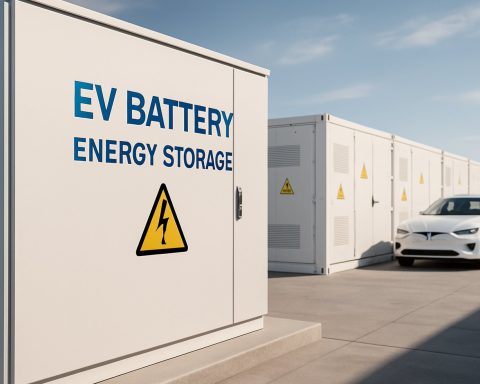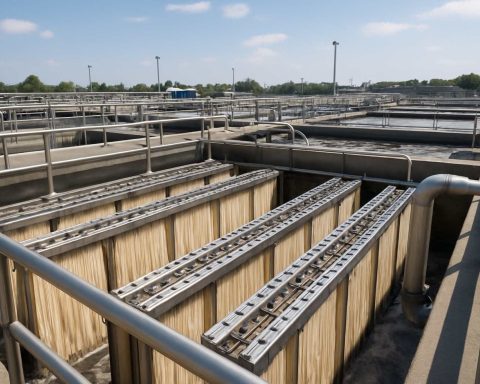- Oklahoma is moving toward energy independence and economic revitalization through nuclear energy legislation.
- House Bill 1375, led by Rep. Brad Boles, calls for a feasibility study on nuclear energy development.
- Sen. George Burns supports nuclear energy with parallel Senate proposals, reflecting a statewide commitment.
- Senate Bill 131 requires companies retiring coal facilities to present strategic plans, favoring nuclear and natural gas replacements.
- The initiative aims to transform Oklahoma into a hub for reliable and innovative energy sources.
- Sen. Dave Rader emphasizes that this is a pivotal moment for advancing nuclear power in the state.
- The overarching goal is to redefine Oklahoma’s energy identity with a focus on sustainability and economic growth.
Oklahoma’s legislative corridors hummed with quiet urgency this week as decisive bills on nuclear energy seamlessly navigated through critical committees. These bills represent more than legislative progress; they signal an electrifying shift toward energy independence and economic revitalization across the Sooner State.
Rep. Brad Boles initiates momentum with House Bill 1375, envisioning a future where nuclear plants dot Oklahoma’s energy landscape. The bill mandates a comprehensive feasibility study, signaling Oklahoma’s commitment to exploring its nuclear potential. Meanwhile, the Senate mirrored this ambition, buoyed by Sen. George Burns’ parallel proposals. This legislative dance reflects a larger vision: to weave nuclear energy into the state’s industrial tapestry.
In these committee rooms, the air was thick with anticipation, as lawmakers recognized an opportunity to transform Oklahoma into a powerhouse of reliable energy sources. Sen. Kristen Thompson painted a vivid portrait of a future where industry thrives and local economies pulsate with new life.
The sweeping narrative continued with measures to replace aging coal facilities with cutting-edge nuclear reactors or natural gas plants. Under Senate Bill 131, companies must share their strategic roadmap for any retirements, emphasizing thorough cost analyses and clear justifications for their choices.
Historically, nuclear ventures have faced hurdles in Oklahoma, yet Sen. Dave Rader insists now is the moment to harness nuclear energy’s power. The call to action is urgent and clear. With these bold legislative steps, Oklahoma isn’t just catching up; it’s commanding the energy frontier.
The takeaway is resounding: Oklahoma is racing ahead, ready to redefine its energy identity. As the sun sets over its plains, a new dawn of innovation and independence beckons.
Oklahoma’s Quest for Nuclear Power: A Bold Leap Towards Energy Independence
How-To Steps & Life Hacks: Initiating Nuclear Projects
For stakeholders looking to venture into nuclear energy projects in Oklahoma, a comprehensive feasibility study as mandated by House Bill 1375 is crucial:
1. Identify Site Locations: Research potential sites for nuclear plants considering geographical stability and economic feasibility.
2. Conduct Environmental Assessments: Ensure compliance with environmental regulations by performing thorough impact studies.
3. Build Community Support: Engage local communities through informational sessions to build public acceptance and understanding.
4. Secure Funding: Explore federal and state grants, partnerships, and private investments to fund the project.
5. Compliance and Permits: Acquire all necessary permits and ensure compliance with the Nuclear Regulatory Commission (NRC).
Real-World Use Cases and Industry Trends
Countries like France and South Korea are exemplars of nuclear energy success. France produces around 70% of its electricity from nuclear energy, reflecting high efficiency and reliability. Similarly, South Korea’s robust nuclear industry has made it a leader in technological innovation. These examples illustrate the potential for economic and energy security benefits.
In the U.S., the nuclear industry is shifting towards small modular reactors (SMRs), which offer advantages in scalability and potentially lower capital costs. Oklahoma’s legislation, emphasizing feasibility studies and strategic roadmaps, is in line with these international and domestic trends.
Market Forecasts and Industry Trends
According to a report by the International Atomic Energy Agency (IAEA), nuclear energy is expected to grow steadily over the next decade, potentially contributing significantly to global clean energy production. The trend towards SMRs presents opportunities for states like Oklahoma to become pioneers in this technology.
Reviews & Comparisons
Nuclear energy is lauded for its low greenhouse gas emissions. In contrast, fossil fuels are prone to pricing volatility and higher environmental impact. Renewable sources like solar and wind are intermittent, making nuclear a reliable backbone.
Controversies & Limitations
Nuclear energy faces challenges, such as high upfront costs, waste disposal concerns, and safety risks. Past incidents, though rare, have shaped public perception. It’s imperative for Oklahoma to address these issues through rigorous safety protocols and transparent waste management strategies.
Features, Specs & Pricing
Small modular reactors (SMRs) are poised to be a game changer. They are designed to be safer and more cost-effective, with a smaller environmental footprint. The upfront investment remains a barrier, but decreasing costs due to technology advancements make them more appealing.
Security & Sustainability
Nuclear power is a low-carbon energy source, crucial for sustainability goals. Oklahoma’s initiative resonates with global efforts to reduce carbon emissions and combat climate change. Comprehensive security measures must be in place to protect facilities against potential threats.
Insights & Predictions
Experts predict that early adopters like Oklahoma could see economic revitalization through job creation and energy exports. This pursuit aligns with the state’s ambition to diversify its energy portfolio, reducing reliance on fossil fuels.
Pros & Cons Overview
Pros:
– Reliable and consistent energy supply
– Low carbon emissions
– Potential for economic benefits and job creation
Cons:
– High initial costs
– Public safety concerns
– Nuclear waste disposal issues
Actionable Recommendations
1. Engage in Public Education: Demystify nuclear energy’s risks and benefits to garner community support.
2. Foster Innovation: Invest in SMR research and development to stay ahead in the energy sector.
3. Collaborate with Experts: Work with institutions and companies that have nuclear expertise to ensure best practices.
Quick Tips for Stakeholders
– Regularly update safety protocols to ensure community confidence.
– Utilize federal programs for financial assistance in nuclear projects.
– Monitor technological advancements and apply them to increase efficiency and safety.
For more about trends in nuclear energy, visit IAEA or FEMA for emergency management and safety planning related to nuclear facilities.











